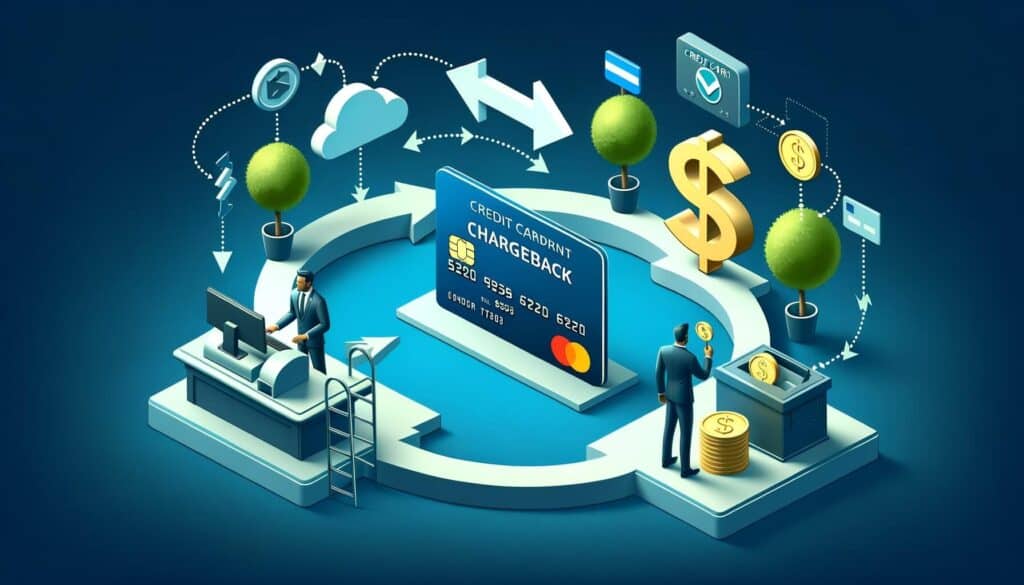
By Catharine Proctor April 28, 2025
In today’s digital age, online transactions have become an integral part of our lives. Whether it’s purchasing goods or services, we rely heavily on electronic payments. However, with the convenience of online transactions comes the risk of chargebacks. Understanding chargebacks is crucial for both merchants and consumers to protect themselves from fraudulent activities and ensure fair transactions.
In this comprehensive guide, we will delve into the definition of chargebacks, how they work, the step-by-step process, common reasons for chargebacks, and how to prevent them. We will also provide a detailed guide on how to dispute a chargeback, including gathering evidence and presenting a strong case. To illustrate the concepts discussed, we will present a real-life chargeback example. Finally, we will address frequently asked questions about chargebacks and conclude with key takeaways.
What is a Chargeback and How Does it Work?

A chargeback is a process that allows consumers to dispute a transaction and request a refund from their bank or credit card issuer. It serves as a consumer protection mechanism, providing a safety net against fraudulent or unauthorized transactions. When a chargeback is initiated, the funds are temporarily reversed from the merchant’s account and returned to the consumer. The burden of proof lies with the merchant to prove that the transaction was legitimate.
Chargebacks can occur for various reasons, including unauthorized transactions, non-receipt of goods or services, defective products, or dissatisfaction with the purchase. They can be a result of fraud, merchant error, or customer dissatisfaction. The chargeback process is governed by card networks such as Visa, Mastercard, and American Express, as well as regulations set by financial institutions.
The Chargeback Process: Step-by-Step Guide

Understanding the chargeback process is essential for both merchants and consumers to navigate the dispute resolution system effectively. Here is a step-by-step guide to the chargeback process:
1. Initiation: The consumer contacts their bank or credit card issuer to dispute a transaction and request a chargeback. They provide relevant information, such as the transaction details, reasons for the dispute, and any supporting documentation.
2. Investigation: The bank or credit card issuer reviews the dispute and initiates an investigation. They may request additional information from the consumer or merchant to gather evidence.
3. Provisional Credit: If the dispute is deemed valid during the investigation, the consumer is typically issued a provisional credit. This means that the funds are temporarily returned to the consumer’s account while the investigation continues.
4. Merchant Response: The merchant is notified of the chargeback and given an opportunity to respond. They can provide evidence to prove the legitimacy of the transaction or address any issues raised by the consumer.
5. Arbitration: If the dispute cannot be resolved between the consumer and the merchant, it may proceed to arbitration. An independent third party, such as the card network or a dispute resolution organization, reviews the evidence and makes a final decision.
6. Final Resolution: Once the investigation or arbitration is complete, a final decision is made. If the chargeback is upheld, the funds remain with the consumer, and the merchant may be liable for additional fees or penalties. If the chargeback is overturned, the funds are returned to the merchant.
Common Reasons for Chargebacks and How to Prevent Them

Chargebacks can occur for various reasons, and understanding the common triggers can help merchants take proactive measures to prevent them. Here are some of the most common reasons for chargebacks and strategies to minimize their occurrence:
1. Unauthorized Transactions: One of the primary reasons for chargebacks is unauthorized transactions, where a consumer claims they did not authorize or participate in the transaction. To prevent this, merchants should implement robust security measures, such as two-factor authentication and fraud detection systems.
2. Non-Delivery of Goods or Services: If a consumer does not receive the purchased goods or services, they may initiate a chargeback. Merchants should ensure timely delivery and provide tracking information to minimize the risk of chargebacks. Clear communication and responsive customer service can also help resolve any delivery issues.
3. Defective or Substandard Products: Consumers may dispute a transaction if they receive defective or substandard products. Merchants should maintain high-quality standards, provide accurate product descriptions, and offer hassle-free return or refund policies to address customer concerns.
4. Dissatisfaction with the Purchase: Sometimes, consumers may dispute a transaction due to dissatisfaction with the purchase, such as receiving a different product than expected or experiencing poor customer service. Merchants should strive for transparency, accurate product descriptions, and excellent customer support to minimize the likelihood of chargebacks.
5. Billing Errors: Billing errors, such as duplicate charges or incorrect amounts, can lead to chargebacks. Merchants should ensure accurate billing practices, provide clear invoices, and promptly address any billing discrepancies reported by customers.
By addressing these common triggers, merchants can significantly reduce the risk of chargebacks and maintain a positive customer experience.
How to Dispute a Chargeback: A Comprehensive Guide

When faced with a chargeback, merchants must be prepared to dispute the claim effectively. Here is a comprehensive guide on how to dispute a chargeback:
1. Understand the Reason: Carefully review the reason provided by the consumer for the chargeback. Identify any discrepancies or inaccuracies that can be used as evidence to support your case.
2. Gather Evidence: Collect all relevant evidence to prove the legitimacy of the transaction. This may include order details, shipping information, customer communication, and any other documentation that supports your position.
3. Review Policies and Procedures: Familiarize yourself with the policies and procedures set by the card networks and financial institutions. Ensure that you comply with their requirements and deadlines for chargeback disputes.
4. Prepare a Response: Craft a detailed response to the chargeback, addressing each point raised by the consumer. Provide clear and concise explanations, supported by evidence, to counter the claims made against your business.
5. Submit the Response: Submit your response to the bank or credit card issuer within the specified timeframe. Ensure that you follow their guidelines for submitting the response, including any required forms or documentation.
6. Follow Up: Stay proactive throughout the dispute process by following up with the bank or credit card issuer. Keep track of all communication and maintain a professional and cooperative approach.
Gathering Evidence for a Chargeback Dispute
To effectively dispute a chargeback, merchants must gather compelling evidence that supports their case. Here are some key pieces of evidence to consider:
1. Order Details: Provide detailed information about the transaction, including the date, time, and amount. Include any order numbers, invoice numbers, or confirmation emails.
2. Shipping Information: If applicable, provide proof of shipment, such as tracking numbers or delivery receipts. This can help establish that the goods were delivered to the correct address.
3. Customer Communication: Include any relevant communication with the customer, such as emails, chat logs, or phone call recordings. This can demonstrate that you have made efforts to address their concerns or resolve any issues.
4. Product Descriptions: If the dispute is related to product quality or accuracy, provide clear and accurate product descriptions from your website or catalog. Highlight any disclaimers or terms and conditions that may be relevant to the dispute.
5. Return or Refund Policies: If you have a return or refund policy in place, provide evidence of its existence and any communication with the customer regarding their options for returning the product or receiving a refund.
6. Payment Authorization: If the dispute is based on unauthorized transactions, provide evidence of the customer’s authorization, such as signed receipts, IP addresses, or device fingerprints.
By gathering and presenting strong evidence, merchants can increase their chances of winning a chargeback dispute.
Presenting a Strong Case: Tips for Winning a Chargeback Dispute
Winning a chargeback dispute requires presenting a strong case that convinces the bank or credit card issuer of the transaction’s legitimacy. Here are some tips to help merchants increase their chances of success:
1. Be Proactive: Act promptly when notified of a chargeback and respond within the specified timeframe. Delaying or ignoring the dispute can weaken your case.
2. Provide Clear Documentation: Ensure that all documentation is clear, organized, and easy to understand. Use screenshots, invoices, and other visual aids to support your arguments.
3. Be Concise and Persuasive: Craft a response that is concise, persuasive, and addresses each point raised by the consumer. Use clear and professional language to convey your position effectively.
4. Highlight Relevant Policies: If your business has specific policies or terms and conditions that are relevant to the dispute, clearly reference them in your response. This can help establish that the consumer was aware of and agreed to these terms.
5. Maintain Professionalism: Maintain a professional and cooperative tone throughout the dispute process. Avoid personal attacks or emotional language, as it can undermine your credibility.
6. Seek Legal Advice if Necessary: In complex or high-stakes disputes, consider seeking legal advice to ensure that you are following the appropriate legal procedures and maximizing your chances of success.
By following these tips, merchants can present a strong case and increase their chances of winning a chargeback dispute.
Chargeback Example: A Real-Life Scenario
To illustrate the concepts discussed, let’s consider a real-life chargeback example:
John, a consumer, purchases a high-end smartphone from an online retailer for $1,000. However, when the package arrives, he discovers that the product is defective and does not function properly. John contacts the retailer to request a refund, but the retailer refuses to accept the return or provide a replacement. Frustrated, John decides to initiate a chargeback.
John contacts his bank and provides all relevant information, including the transaction details, communication with the retailer, and evidence of the defective product. The bank initiates an investigation and requests additional information from both John and the retailer.
The retailer, upon receiving the chargeback notification, reviews the case and realizes their mistake in refusing the return. They promptly contact John to apologize for the inconvenience and offer a full refund. John, satisfied with the resolution, contacts his bank to withdraw the chargeback.
In this example, the chargeback served as a catalyst for the retailer to rectify their mistake and provide a satisfactory resolution to the customer. It highlights the importance of effective communication and customer-centric policies in preventing chargebacks.
Frequently Asked Questions about Chargebacks
Q1. What is the difference between a chargeback and a refund?
Answer: A chargeback is initiated by the consumer and involves the bank or credit card issuer reversing the transaction and temporarily returning the funds to the consumer. A refund, on the other hand, is initiated by the merchant and involves returning the funds directly to the consumer without involving the bank or credit card issuer.
Q2. Can chargebacks be prevented?
Answer: While chargebacks cannot be completely eliminated, merchants can take proactive measures to minimize their occurrence. By implementing robust security measures, maintaining high-quality standards, providing excellent customer service, and adhering to card network regulations, merchants can significantly reduce the risk of chargebacks.
Q3. How long does the chargeback process take?
Answer: The chargeback process can vary in duration depending on various factors, such as the complexity of the dispute, the responsiveness of the parties involved, and the specific policies of the bank or credit card issuer. On average, the process can take anywhere from a few weeks to several months.
Q4. Can a chargeback be reversed?
Answer: Yes, a chargeback can be reversed if the merchant successfully disputes the claim and provides compelling evidence to prove the legitimacy of the transaction. However, the reversal process can be challenging, and the outcome depends on the strength of the merchant’s case.
Conclusion
Understanding chargebacks is crucial for both merchants and consumers to navigate the complex world of online transactions. By comprehending the definition of chargebacks, how they work, and the step-by-step process, merchants can effectively dispute claims and protect their businesses. Implementing strategies to prevent chargebacks, such as robust security measures and excellent customer service, can minimize their occurrence.
By gathering compelling evidence and presenting a strong case, merchants can increase their chances of winning a chargeback dispute. Real-life examples and frequently asked questions provide further insights into the intricacies of chargebacks. Ultimately, by understanding chargebacks and taking proactive measures, merchants can ensure fair transactions and maintain positive customer relationships.